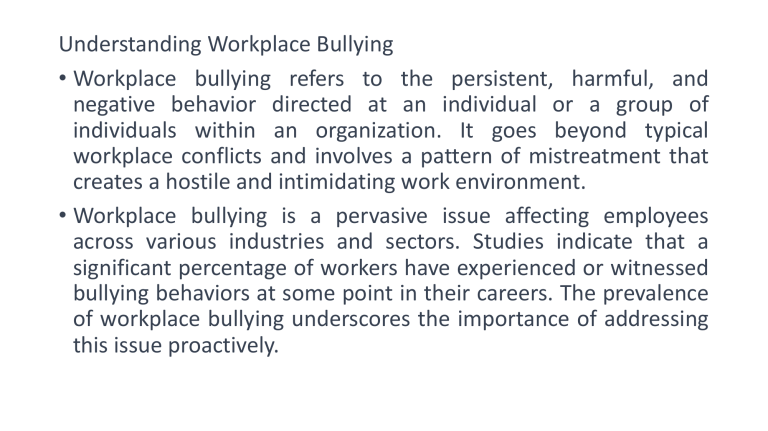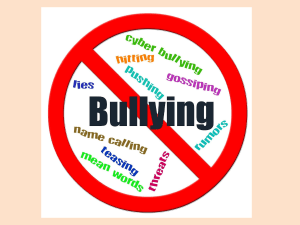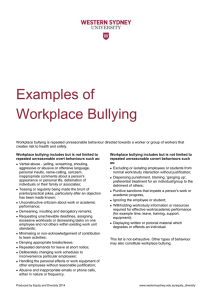
Understanding Workplace Bullying • Workplace bullying refers to the persistent, harmful, and negative behavior directed at an individual or a group of individuals within an organization. It goes beyond typical workplace conflicts and involves a pattern of mistreatment that creates a hostile and intimidating work environment. • Workplace bullying is a pervasive issue affecting employees across various industries and sectors. Studies indicate that a significant percentage of workers have experienced or witnessed bullying behaviors at some point in their careers. The prevalence of workplace bullying underscores the importance of addressing this issue proactively. Impact of Workplace Bullying • Workplace bullying has profound consequences on the mental, emotional, and physical well-being of individuals. It can lead to increased stress, anxiety, depression, and even physical health problems. The toll on personal and professional life can substantially affect job satisfaction and overall quality of life. • The negative effects of workplace bullying extend beyond individual suffering. Organizations that tolerate or ignore bullying may experience increased turnover, reduced employee morale, and decreased overall productivity. Workplace bullying can tarnish a company's reputation, challenging attracting and retaining top talent. Recognizing Workplace Bullying • Behavioral Changes: • Unexplained Absences: Regularly calling in sick or arriving late without a clear reason. • Decreased Work Performance: A noticeable decline in the quality or quantity of work produced. • Changes in Demeanor: Increased irritability, mood swings, or withdrawal from colleagues. • Interpersonal Dynamics: • Changes in Relationships: A sudden shift in colleague relationships, such as avoiding interactions or strained communication. • Exclusion from Activities: Being consistently excluded from work-related events, meetings, or social gatherings. • Visible Signs of Distress: Anxiety, sadness, or frustration during work-related interactions. • Physical and Emotional Indicators: • Health Complaints: Frequent complaints of stress-related health issues, headaches, or other physical ailments. • Changes in Appearance: Significant changes in appearance, hygiene, or personal habits. • Feelings of Targeting: Expressing a sense of being targeted, harassed, or bullied by colleagues. Preventing Workplace Bullying • Develop a Clear Anti-Bullying Policy: • Policy Components: • Clearly define workplace bullying, providing specific examples to enhance understanding. • Outline reporting procedures, detailing how and where employees can report incidents. • Specify consequences for bullying behavior, ensuring a fair and consistent approach. • Dissemination: • Include the anti-bullying policy in the employee handbook, making it easily accessible to all staff. • Conduct regular training sessions to ensure everyone knows the policy and its implications. Handling Workplace Bullying •Encouraging Employees to Incidents: •Safe Reporting Channels: Report • Establish multiple reporting mechanisms, such as confidential hotlines, dedicated email addresses, or an open-door policy. • Clearly communicate the availability of these channels and assure confidentiality. Promoting Respectful Promoting a Supportive Culture: • Emphasize that reporting is a responsible and necessary action to maintain a healthy work environment. • Provide resources and support for individuals who have experienced or witnessed bullying, such as counseling services. • No Retaliation Policy: • Clearly communicate a strict no-retaliation policy to protect those who come forward. • Outline the consequences for anyone found engaging in retaliation against individuals reporting incidents. Building a Positive Work Environment • Encourage Dialogue: • Promote open discussions about workplace dynamics and interpersonal issues. • Create forums, such as team meetings or feedback sessions, where employees can express concerns. • Leadership Example: • Demonstrate the value of open communication at all levels of the organization. • Encourage managers to conduct regular check-ins with their teams to address concerns and promote a positive work environment. Legal and Ethical Considerations • Unlike bullying in school, workplace bullying is not covered by any specific law in the Philippines. Republic Act 10627, or the Anti-Bullying Act, applies to school-related bullying and seeks to address a hostile environment that disrupts the education process. • Labor Code and Occupational Safety and Health Standards: Employers are mandated to provide a safe and healthy working environment. • Failure to address workplace bullying may lead to legal consequences under labor laws. Empowering Employees Conduct Training Programs: • Educating Employees: • Provide comprehensive training on recognizing, preventing, and addressing workplace bullying. • Incorporate real-life scenarios and case studies to enhance practical understanding. • Training for Managers: • Equip managers with the skills to recognize and address bullying incidents effectively. • Stress the importance of leadership in fostering a respectful and inclusive work environment.





